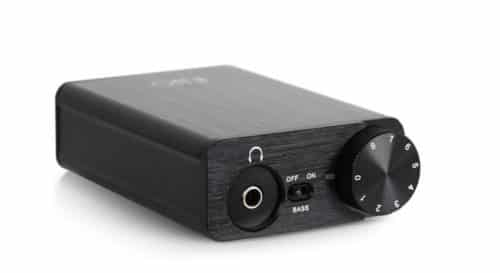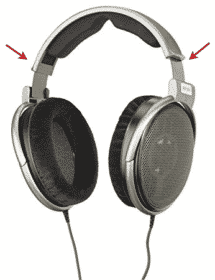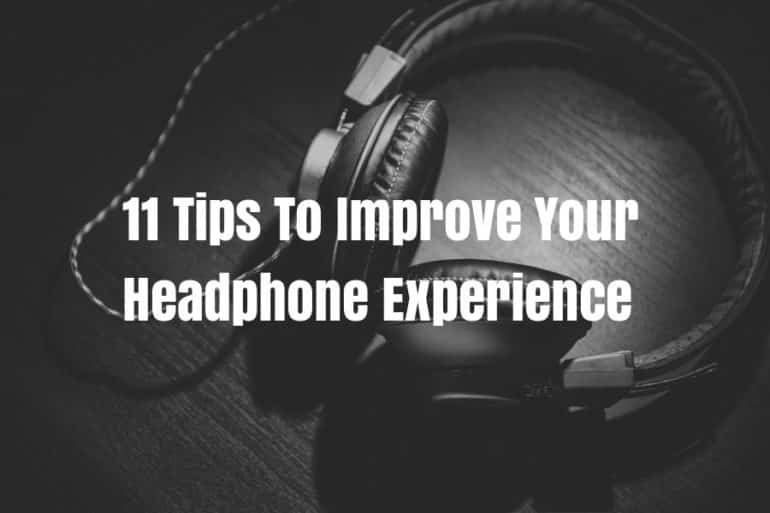Last updated on December 15th, 2020 at 03:56 pm
So, I’m going to make a guess here and assume that if you are reading this, you’re an Audiophile with exquisite hearing that just wants to get the best sound out of his Headphones, be it while using them with your computer, smartphone, or whatever the case may be!
But there are a couple of things you need to take into consideration if you want to have the best experience possible.
In this post I will be going over x tips on how to improve your headphone experience. Some of them will be simple free, while the others may actually require you to invest a bit of money.
Let’s get started…
Tip 1: Invest in higher Quality Headphones!
This is an obvious point, but it’s still the most important one! You just can’t get a cheap pair of in-ear headphones and expect them to sound absolutely fantastic, it just won’t work!
In fact, I recommend open back Headphones, such as the ones they use in mixing studios.
Of course, there is one con to these kinds of Headphones: Since they are open back, this means that they don’t isolate the sound as well as closed back ones.
Why does this matter?…
Well, if you plan on using them on the Subway, or in a public place where there’s a lot of background noise, you will hear everything around you while the rest of the world will also be able to hear to whatever it is you are listening to.
These Headphones, however, tend to have the best Audio Quality of all.
I Wrote a whole post on why the Sennheiser 650HD Headphones are great for mixing, you should check it out!
It mostly comes down to personal preference. I like the Open back ones more, especially for listening or mixing music at home. But I would never use them in a public place.
One issue with high quality Headphones is that they are normally very power hungry! Which brings me to my next tip…
Tip 2: Invest in a DAC/preamp!
Let’s start by asking, what a DAC actually is?
DAC stands for “Digital-to-analog converter”. It’s basically a device that converts a digital signal into an analog one which can then be outputted to the speakers/headphones so you can actually hear it.
Once the signal is converted, it needs to be amplified. Absolutely all devices have a DAC built into them, your phone, your laptop, etc. Otherwise you wouldn’t be able to listen to music on them.
BUT, are those Digital to Analog Converters actually good? Are they better than the external ones at improving sound quality?
All devices also have an amplifier to make the signal louder, but most amps built into them aren’t powerful enough to drive these power-hungry Headphones. They were designed for smaller ones, with a really low Impedance.
So naturally, adding an external Amp will significantly improve the sound quality and the volume level of what you are listening to.
Should you really buy a DAC/amp?

Before you buy an external amplifier, you should first check how well you think your headphones actually sound on your devices.
Some of the latest smartphones actually have a pretty good DAC built into them, you might not get the BEST quality out of them, but investing in an extra DAC might not be necessary.
One BIG factor you need to check is your Headphones Impedance. In my case, I use the Sennheiser 650HD which have an Impedance of 300 Ohms.
If I connect them to my phone, I can listen to music…sure, but the Volume and sound quality are just not there.
Another thing to take into consideration is that maybe, you aren’t listening to the highest quality of music… By this I mean, that if you are playing a 128Kbps MP3, what’s the point of getting the best Headphones and Amplifier if what you are reproducing is already low quality?
Try and use FLAC or full uncompressed WAV. Yes, it will eat up the storage on your phone, but the listening experience will be much better.
Now the question is, how much does a DAC/amp combo cost?…
Since there’s a wide variety of DAC/amps, the price will depend on what you are going to use them for. They range from about $70-$80 up to almost $3000 dollars.
Which one is the best for you?
This all comes down to how much of an Audiophile you really are, how much control you want, what your music source is (more on that later in this post), what headphones you are using… Do they need a lot of power to be driven properly or not? And lastly, how much you are willing to spend.
If you don’t know which one is best for your headphone, it’s pretty simple to find out! High Impedance Headphones require more power to be driven properly, while lower Impedance ones require more current.
You can then look at the amp specifications to find out whether or not it’s the right one for you.
I would recommend either the Fiio 10k, which is a very affordable one, or should you need something a bit better, then the Fiio Q5 would be a good choice also. This one is much more expensive though.
Tip 3: Use Apps to improve the Sound.
While I personally don’t do this, because I like to hear everything exactly how it’s supposed to be heard, you can sometimes use some apps to quickly alter the sound signature of your Headphones.
When can this be useful?…
You could tone down the bass. We all know how in todays music the bass is just way too loud, commercial Headphones even emphasize this on purpose, because that’s what everyone is trying to sound like.
An EQ could quickly fix this issue!
Another useful tip is to use EQ to lower unwanted sibilance on vocals.
How to find the frequencies you need to lower? Start by boosting the frequencies where the vocal sibilance usually happens, this is around the 3kHz to 7kHz range.
Once you find the exact frequency range, which increase the sibilance while boosting it, cut them down a bit.
There are many EQ apps you can download for your phone from the App Stores.
If you are listening on your PC, there are simple EQ programs you can use.
Tip 4: Loosening a tight Headband!

Oh, this is a big one for me. I owned a couple of Headphones and one recurring issue I had was that the headband always felt a bit tight…
Like I state in my post about the Sennheiser 650HD, they are my favorite headphones BUT honestly, the Headband was the biggest issue.
The solutions: Either replace the whole headband, if the headphone allows it OR, do what I did and leave the Headphone over a shoebox for a day or two.
This will stretch the Headband out a bit.
One thing you should always consider before doing this is to remove the earpads, since they will be under more pressure than usual and for a long period of time. This may decrease the earpad’s lifespan.
Tip 5: Replace the earpads!
Earpads that ship with most Headphones aren’t bad, but they can definitely be changed for better ones.
This is good for a couple of reasons…
They may fit better over your ears, creating a more comfortable experience. Plus, they might also help with Isolation.
Another reason is that the standard ones tend to wear out a bit faster, getting better ones might be a smart choice in the long run.
Tip 6: Get Headphones that can be disassembled, if possible!
Nothing is more frustrating than spending all that money on those fancy Headphones and not be able to replace certain parts either because you want to improve them or because something broke.
Of course, this isn’t something you should worry about THAT much if you bought them from a reputable company, since they should be of great quality and hopefully last a lifetime. But it’s still a nice bonus.
That’s another thing I like so much about the Sennheiser 650HD, you can manually disassemble them and change whatever you want.
Tip 7: Increase the Audio Quality!

I already mentioned this a bit earlier in the post, but if you care about getting the best audio performance, you should start at the source.
Most streaming audio sources, such as Spotify, won’t give you the best quality… This is because they are Internet reliant, and streaming 50Mb songs wouldn’t be the smartest way to go about it.
Plus, most people don’t even use the right gear to be able to notice the difference.
If you are really interested in getting the most out of your Headphones, start by using FLAC or pure uncompressed WAV.
If you don’t have that alternative, make sure to go into the streaming services settings and choose the highest quality possible.
If you can’t hear the difference in audio quality just yet, don’t worry…most people can’t at first, you just need some time to adjust.
But after a while you will be able to, which now means that after you do, compressed audio files will sound terrible to you. You will be able to notice that the bass sounds more buddy, High frequency clarity might sound less crisp, etc.
Next two tips are about increasing the Headphones Lifespan.
Tip 8: Take care of the cable!
This is probably the most common mistake, yet the one that will shorten the life of your Headphones the quickest.
You need to wind the cable the right way. Use a couple of your fingers to wind the cable around, make sure it’s not too tight.
Why is this so important?…
Internal cable damage is a common issue with Headphones, even though the outside of the cable looks completely intact. Over time this will lead to some audio issues or will straight up kill the sound.
Check if the cables are detachable, this will make the winding up of the cables a lot easier. They usually have a Velcro wrap to secure it.
Over time, all cables will break a bit, even if you treat them with care, this is where detachable cables are another good choice since you simply replace them once this happens.
Even if you can’t detach them, you should wind them up and secure them with either a Velcro what or a twist tie.
Tip 9: Keep them clean!
One important thing you need to know is your Headphones IP Rating. This is basically a scale that tells you how waterproof the headphones are.
Most of them are at least prepared to tolerate sweat. You can probably find this rating on the item’s specifications sheet. If they are close to a level 7 IP, you could probably rinse them off if they get sweaty… be absolutely sure that you can do this before you even attempt to.
One other thing you could do is changing the earpads, which Sennheiser allows you to do, or change the tips, if you are using in-ear headphones.
Tip 10: Changing the tips on you in-ear headphones!
Apart from getting good quality In-ear Headphones, one thing you should consider is changing the tips…
When I bought mine, the standard tips were too small and they would simply fall out every two minutes, this was extremely frustrating, so I purchased three different sizes and tried them all on until I found a pair that was actually comfortable.
One thing I have to say about in-ear headphones though is, if possible…don’t use them.
This is because of what I’ll explain in the next and final tip…
Tip 11: Preserve your Hearing!
We all love listening to music, and most people actually like really loud volumes, which can be detrimental for your hearing.
Listening to music at high volumes can, overtime, can create permanent nerve damage causing hearing loss. Of course, this takes time, you will not nice it immediately, but believe me it will add up over time.
In regards to the In-ear Headphones, I personally haven’t really experienced any issues, mostly because I almost never use them.
Despite that, they don’t recommend them because they get too close to the ear drum if you push them too far in, and can damage it.
Next point is in favor of the Closed-back headphones.
Even though I like Open-back ones better for listening to music at home or for mixing, closed back headphones are better at isolating the sound, which means that all the outer noise will have a harder time reaching your ears.
Why does this matter?…
Well, the biggest factor regarding Hearing loss is the volume. The higher the volume, the more you will damage your hearing.
Since closed-back headphones are better at isolating the sound, you won’t need to crank the volume up to overcome all the ambient noise.
Conclusion:
If you are really interested in listening to music at its best, you should definitely consider getting the best Headphones possible, while also spending some money on a good DAC/amp (only if you really need it).
Also consider getting better quality files, you could have the most expensive setup but if the source is low quality, nothing you do afterwards will fix this!
And please take care of your hearing!
I hope you found this information useful! See you on the next one!
